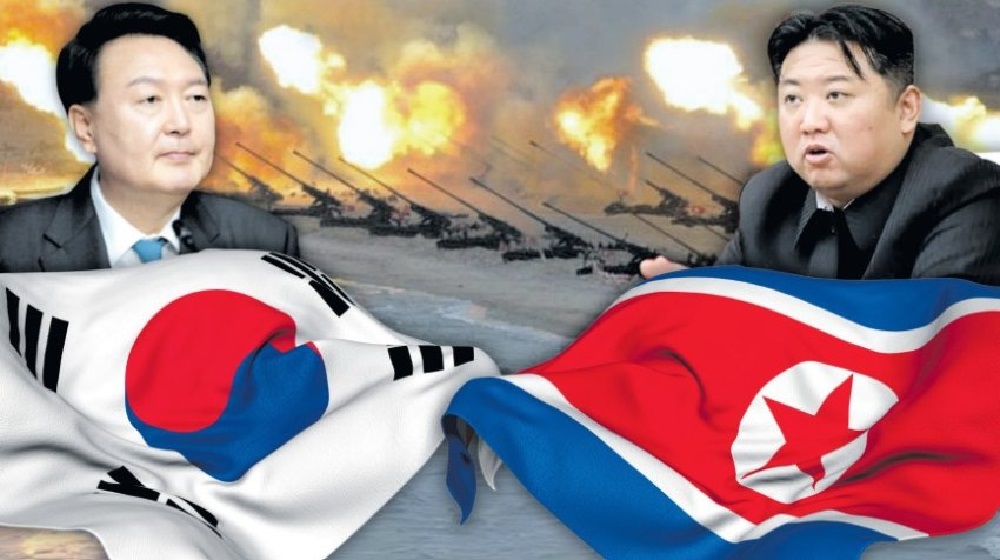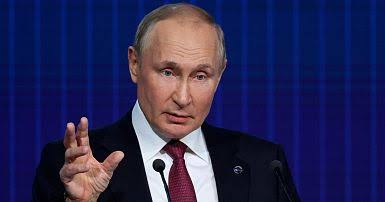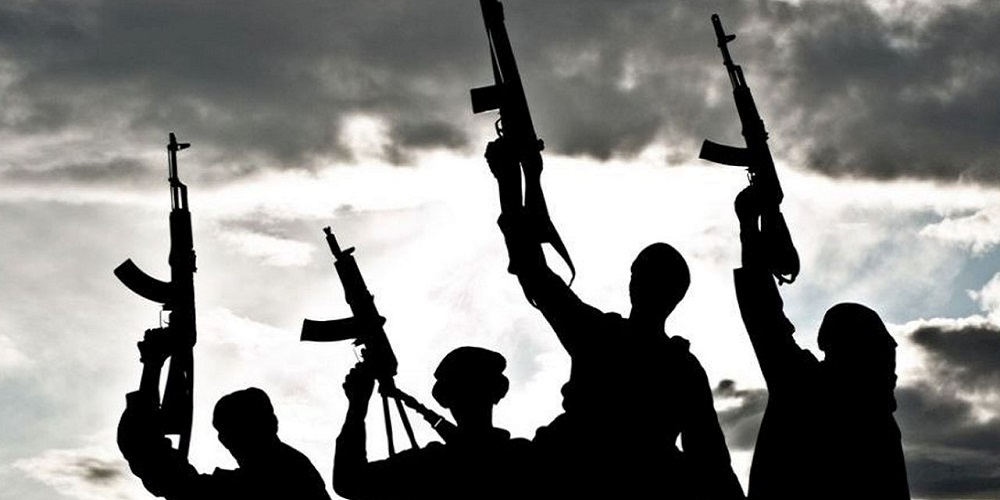Foreign
Tensions flare between North and South Korea

South Korea is fed up with North Korea’s garbage—literally. Last week, North Korea sent around 3,500 balloons full of manure, scrap paper, and cigarette butts over the border into South Korea, in response to South Korean activist groups sending balloons with propaganda leaflets and other contraband to their isolated neighbors to the north.
And even though no one was hurt by the North Korean deliveries—and Pyongyang promised to pause the mud-slinging for now—the damage had been done. The relative calm on the Korean Peninsula was officially trashed.
On Tuesday, Seoul suspended a six-year-old military agreement with Pyongyang that aimed to decrease tensions between the two countries by requiring both sides to stop holding military drills or carrying out psychological warfare activities in border areas. It’s a move that has some officials and experts worried that hostility on the Korean Peninsula—already on the rise after North Korea carried out an underwater nuclear test in January—could blow through the roof.
Tit-for-tat. The scrapped 2018 deal dated back to former South Korean President Moon Jae-in’s time in office, where he sought direct rapprochement with the north in three successive meetings with North Korean dictator Kim Jong Un. Both sides agreed to stop blaring propaganda messages across the border at one another and to halt live-fire exercises within the 400-square-mile demilitarized zone (DMZ) along the 38th parallel that roughly splits the two countries.
But even before Seoul killed the deal, relations on the Korean Peninsula were already deteriorating. North Korea’s failed launch of a military spy satellite in late May prompted South Korea to conduct air drills with 20 fighter jets—including F-35s, F-16s, and F-15s—maneuvering near the no-fly zone along the DMZ. And that’s when North Korea started sending trash balloons over the border.
“We cannot help being enraged by such intolerable saber-rattling, a blatant violation of our national sovereignty,” Kim said. He called South Korea a “gangsters’ regime.” And he punctuated his comments by firing 18 short-range ballistic missiles in a military drill.
Now, the Americans are involved. On Wednesday, the United States sent a long-range B-1 bomber over the Korean Peninsula in joint drills with Seoul and dropped precision-guided bombs. It was the first time that had happened in seven years. It last occurred during the war of words between former U.S. President Donald Trump and Kim that lasted for most of 2017.
Unwelcome distraction. For the last three years, the Biden administration has said that the U.S. will meet with North Korea anytime, anywhere, and without preconditions—a message that Pyongyang has pointedly ignored, even as Biden himself publicly repeated the pledge during Japanese Prime Minister Fumio Kishida’s visit to Washington in April.
But the flare-up in tensions comes at a time when the United States is trying to get South Korea to focus outside of the Korean Peninsula and repair relations with Japan to deal with the threat of China’s military rise.
Historical animosity stemming from Japan’s World War II-era occupation of Korea, including the military sexual enslavement of thousands of Korean women, had undermined the prospect of a diplomatic thaw for most of the past eight decades. But Seoul and Tokyo had a “kumbaya” moment at a Camp David summit with Biden, Kishida, and South Korean President Yoon Suk-yeol in August 2023. Earlier this week, all three countries agreed to hold joint military exercises, and Japan and South Korea agreed to re-normalize defense ties in a significant step toward overcoming those historical issues.
Now, South Korea’s military assets—and the political bandwidth to keep an eye on China—are once again being diverted to deal with North Korea’s threats.
Biden has nominated Julie Smith to serve as the undersecretary of state for political affairs, the State Department’s fourth-ranking job. The role has been vacant since Victoria Nuland retired in March. Smith will stay on in her current job as U.S. ambassador to NATO while she goes through the confirmation process.
Biden has also tapped Kin Moy to be U.S. ambassador to Vietnam and James Story to be U.S. ambassador to Mozambique. Both are career foreign service officers.
Kelly Magsamen, the chief of staff to U.S. Secretary of Defense Lloyd Austin, is set to leave her job at the end of the month after three and a half years.
House Speaker Mike Johnson has appointed Reps. Scott Perry of Pennsylvania and Ronny Jackson of Texas to serve on the House Intelligence Committee, putting two close Trump allies on the powerful congressional panel charged with overseeing U.S. spy agencies.
Johnson has also tapped Republican U.S. Rep. Ben Cline of Virginia to serve on the China select committee.
Beyond the Russian border. The Biden administration is now allowing Kyiv to hit targets inside Russia close to the Ukraine border with U.S. arms, and Ukraine hasn’t wasted any time since it got the green light. By Wednesday, Ukraine had already struck inside Russia with U.S. weapons, congressional aides and NATO officials told us, as Russia ramps up attacks on the Ukrainian city of Kharkiv near the Russian border. Other European countries, including the United Kingdom, France, and Germany, have given Ukraine similar approvals.
Some officials and congressional aides we’ve spoken to (all spoke on condition of anonymity to discuss sensitive matters) concede there’s a chance this could further escalate tensions between Russia and NATO, particularly as Russian President Vladimir Putin floats more nuclear threats. Others believe the policy is necessary for Ukraine to defend itself and are frustrated the Biden administration has taken so long to approve the measure, believing the White House is leaning too far into micromanaging how Ukraine uses U.S. weapons systems.
We just want to talk. The Chinese People’s Liberation Army (PLA) has been aggressively recruiting former fighter pilots from NATO countries to train members of its air force and naval aviators, according to a bulletin issued Wednesday by the Five Eyes intelligence alliance composed of the United States, United Kingdom, Canada, Australia, and New Zealand.
“The PLA wants the skills and expertise of these individuals to make its own military air operations more capable while gaining insight into Western air tactics, techniques, and procedures,” the notice said. Front companies around the world have offered potential recruits “exorbitant salaries,” Michael C. Casey, the director of the U.S. National Counterintelligence and Security Center, said in a statement.
“Somalia on steroids.” The U.S. special envoy for Sudan told Foreign Policy that the East African country’s ongoing civil war could devolve into a failed state, warning that it could become “Somalia on steroids,” as Robbie reported this week.
Sudan’s civil war, one of the world’s deadliest conflicts, has killed around 150,000 people by some estimates and been the scene of widespread atrocities including ethnic cleansing and potentially genocide. It has significant geopolitical implications as well: Russia is eyeing establishing a naval refueling station in Sudan on the strategically important Red Sea coast in exchange for supplying the Sudanese Armed Forces with more weapons.
Toxic workplace. U.S. military personnel responsible for maintaining America’s nuclear weapons arsenal were exposed to dangerous toxins and chemicals without proper safety equipment or support from the Air Force, according to a new investigation from Military.com. “Many believe their jobs repairing intercontinental ballistic missiles contributed to prolonged illnesses and cancer diagnoses,” the report found.
Foreign
Burkina Faso, Mali, Niger seek access to Atlantic through Morocco

Foreign ministers of military-ruled Sahel states of Burkina Faso, Mali and Niger said on Monday they endorse an initiative offering them access to global trade through Morocco’s Atlantic ports, Reuters reported.
The foreign ministers expressed their countries’ position during a meeting with Morocco’s King Mohammed VI in Rabat, it said.
The West African nations, run by military leaders who took power in coups in recent years, withdrew from the regional grouping ECOWAS last year and formed an alliance known as the Confederation of Sahel States (AES).
Morocco, a major investor in West Africa’s financial and agricultural sectors, announced its trade access initiative in November 2023, after ECOWAS imposed trade restrictions on the three states.
The initiative is conducive to “diversifying our access to the sea,” Mali’s foreign minister Abdoulaye Diop told state media.
The meeting “is part of the strong and longstanding relations of the Kingdom with the three brotherly countries of the Alliance of Sahel States,” Morocco’s news agency said.
The visit takes place as relations between the AES and Algeria, Morocco’s regional rival, deteriorate.
Algeria has cut ties with Morocco and backs the Polisario Front which seeks an independent state in Western Sahara, a territory Morocco considers its own and where it is building a port worth $1 billion.
The new AES grouping expelled French and other Western forces and turned towards Russia for military support.
In December, Morocco mediated the release of four French spies held in Burkina Faso, five months after Paris recognised Rabat’s sovereignty over Western Sahara.
Foreign
Massive power outage hits Spain, Portugal

A massive power outage paralyzed Spain and Portugal on Monday in an incident with no immediate explanation.
“It’s best to not speculate. We will know the causes soon. We are not discarding any hypothesis, but right now, we just focus on what’s most important: returning electricity to our homes,” Spanish Prime Minister Pedro Sánchez said at a news conference Monday.
The stoppage, which occurred about 12:30 p.m. Madrid time, caused chaos across the Iberian Peninsula and showed the vulnerability of Europe’s electrical grid — even on days without extreme weather or spiking demand.
Trains stopped running. Hospitals canceled surgeries, according to news agencies, and depended on backup generators. Business ground to a halt as machines were unable to process credit card transactions. The outage even suspended several Madrid Open tennis matches, with photos showing a court with nonfunctioning scoreboards and darkened stands. Sánchez urged citizens to restrict cellphone use and to call emergency dispatchers only “when it is really necessary.”
By about 5:30 p.m. Madrid time, Red Eléctrica, the corporation that operates Spain’s electricity grid, said some power had been restored across corners of the peninsula, including parts of Catalonia, the Basque Country and Andalusia. About two hours later, the utility provider said more than a fifth of the peninsula’s power had been recovered. Full recovery may take up to 10 hours, Red Eléctrica told Spanish news outlets, which means the country’s power could be restored some time late Monday.
“Causes are being analyzed, and all resources are being dedicated to addressing the issue,” Red Eléctrica said in a statement.
More than 50 million people live on the Iberian Peninsula, but authorities did not provide an immediate estimate for the number of people affected by the outage. Portugal’s national grid operator described it as a “massive cut” in electricity supply across the peninsula. Data from Red Eléctrica showed a sudden plunge in electricity demand from about 27,000 megawatts to less than 13,000. Levels remained abnormally low two hours later.
Spain’s Energy Ministry said in a statement that Sara Aagesen, a deputy prime minister, visited the Red Eléctrica control center to “learn about the situation firsthand and monitor the incident.”
“All necessary measures will be put in place to restore normality as quickly as possible,” the statement said.
Prime Minister Sánchez also held a meeting at the control center, with Aagesen and several other ministers present, the Spanish newspaper El País reported, and Spain’s National Security Council called a meeting to address the outage.
Portugal’s Lusa News Agency said the country’s cybersecurity center had seen no evidence so far that the blackout stemmed from a cyberattack. Separately, the Reuters news agency quoted unnamed officials as saying a cyberattack had not been ruled out.
The Spanish grid also connects with Morocco, France, Andorra and Portugal. Spain and France experienced a major blackout on July 24, 2021, but it lasted less than an hour.
Previous power outages in Europe have been caused by technical problems, lightning strikes and damaged cables. In 2003, Italy faced a huge blackout because a tree was too close to a power line, resulting in a flashover, or a jump of electricity from the line to vegetation.
Foreign
Putin announces three-day Russian ceasefire in Ukraine from 8 May

Russian President Vladimir Putin has announced a temporary ceasefire for the war in Ukraine.
The Kremlin said the ceasefire would run from the morning of 8 May until 11 May – which coincides with victory celebrations to mark the end of World War Two.
In response, Ukraine’s Foreign Minister Andrii Sybiha called for an immediate ceasefire lasting “at least 30 days”.
While US President Donald Trump, who has been attempting to broker a truce between the two sides, said he wants to see a permanent ceasefire, the White House said.
The Kremlin announced a similar, 30-hour truce over Easter, but while both sides reported a dip in fighting, they accused each other of hundreds of violations.
Ceasefires have been attempted more than 20 times in Ukraine – all of them failed eventually, and some within minutes of going into effect.
The most recent one, over Easter, was very limited in scope and only resulted in a slight reduction in fighting, with both sides accusing each other of violating the truce.
In a statement on Monday, the Kremlin said Putin declared the ceasefire “based on humanitarian considerations”.
A translation of the statement said: “Russia believes that the Ukrainian side should follow this example.
“In the event of violations of the ceasefire by the Ukrainian side, the Armed Forces of the Russian Federation will give an adequate and effective response.
“The Russian side once again declares its readiness for peace talks without preconditions, aimed at eliminating the root causes of the Ukrainian crisis, and constructive interaction with international partners.”
Following its release, Ukrainian Foreign Minister Sybiha said: “If Russia truly wants peace, it must cease fire immediately.”
“Why wait until May 8th?” he wrote on X. “If the fire can be ceased now and since any date for 30 days—so it is real, not just for a parade.”
He said Ukraine is ready to support a “lasting, durable, and full ceasefire. And this is what we are constantly proposing, for at least 30 days”.
White House press secretary Karoline Leavitt said Trump was growing “frustrated with leaders of both countries”.
“He wants to see a permanent ceasefire.
“I understand Vladimir Putin this morning offered a temporary ceasefire. The president has made it clear he wants to see a permanent ceasefire first to stop the killing, stop the bloodshed.”
The latest announcement comes during what the US has described as a “very critical” week for Russia-Ukraine peace talks.
Washington has been trying to broker a deal between the two sides, but the Donald Trump administration has threatened to pull out if they do not see progress.
Putin is keen to create the impression that Russia is serious about seeking peace – and he is keen for Trump to hear that message given Ukraine has accepted Washington’s proposal for a more lasting 30-day ceasefire.
It comes after the US president expressed annoyance with Russia’s continued attacks on Ukraine.
Russia launched a full-scale invasion of Ukraine on 24 February 2022, and currently controls about 20% Ukraine’s territory, including the southern Crimea peninsula annexed by Moscow in 2014.
It is estimated that hundreds of thousands of people – the vast majority of them soldiers – have been killed or injured on all sides since 2022.
-

 Metro22 hours ago
Metro22 hours agoGunmen storm University of Benin teaching hospital, kill doctor
-

 Metro23 hours ago
Metro23 hours agoFCTA destroys 601 motorbikes over violations
-

 News14 hours ago
News14 hours agoAlleged money laundering: EFCC produces Aisha Achimugu in court
-

 News22 hours ago
News22 hours agoJust in: FG declares tomorrow public holiday
-

 News16 hours ago
News16 hours agoJUST IN: Major General Paul Ufuoma Omu Rtd, dies at 84
-

 News15 hours ago
News15 hours agoTinubu hails Dangote’s World Bank appointment
-

 News9 hours ago
News9 hours agoHon. Dennis Agbo Resigns From Labour Party
-

 News9 hours ago
News9 hours agoJust in: Osun PDP receives defectors from APC, others






